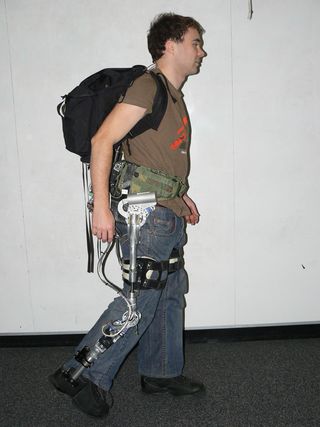Powerful Ideas: Alcohol Could Run Artificial Muscles

Editor's Note: This occasional series looks at powerful ideas — some existing, some futuristic — for fueling and electrifying modern life. Artificial muscles driving the robots or prosthetic limbs of the future might be powered by the kind of alcohol that can make people blind. "You can imagine robotic soldiers fighting ahead of human soldiers and getting a drink of alcohol to fight on," said materials scientist Ray Baughman, director of the University of Texas at Dallas NanoTech Institute. "It makes a pretty image to imagine the robot getting the alcohol from a bar, but it's not the kind of alcohol humans like." Scientists have experimented with artificial muscles for decades. These often work by converting electricity into mechanical energy, but the problem there is that batteries neither deliver energy very quickly nor store energy efficiently given the space they occupy, Baughman explained. Instead of using batteries, artificial muscles could rely on chemical fuels, Baughman suggests. For instance, methanol, or wood alcohol, which can blind people, "has 30 times the energy storage density of a conventional battery," he said. So far the most powerful type of muscle Baughman and his colleagues have created is made from a nickel-titanium alloy coated in platinum particles only nanometers or billionths of a meter wide. The nanoparticles behave as catalysts, helping fuels such as methanol, hydrogen or formic acid to react with the oxygen in the air, generating heat. The alloy does not expand when heated, unlike most materials. Instead, it contracts, generating roughly 500 times more force than natural muscles of the same diameter. "We can generate giant forces on very short time scales," Baughman said. The main problem this muscle faces is cooling off so it can get reused. One idea to solve that concern involves evaporating methanol off the system to cool the muscles down, much as evaporating sweat helps cool down human bodies. Another issue with this muscle is that its motions can jostle the nanoparticles off. One recent improvement to this muscle Baughman and his colleagues devised involves wrapping the muscle in a sheet of carbon nanotubes, which acts as a durable, lightweight webbing to hold the particles on. If all these hurdles are overcome, these artificial muscles could find use in prosthetic limbs, exoskeletons under development to enhance human strength, droids that fly or swim, or humanoid robots that march in the front lines of battle. "Even the most effective humanoid robots like Asimo from Honda can only operate for 30 to 45 minutes before they need to recharge, and recharging its batteries can take about four hours," Baughman said. "If one used fuel-powered artificial muscles instead of systems driven by batteries, one could stay much longer in operation."
- Readers Pick : Top 10 Alternative Energy Bets
- Powerful Ideas: Miles-High Kites Could Generate Electricity
- Powerful Ideas: Humans as Renewable Sources
Sign up for the Live Science daily newsletter now
Get the world’s most fascinating discoveries delivered straight to your inbox.

Most Popular


